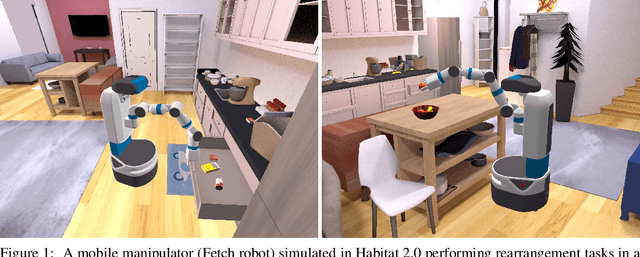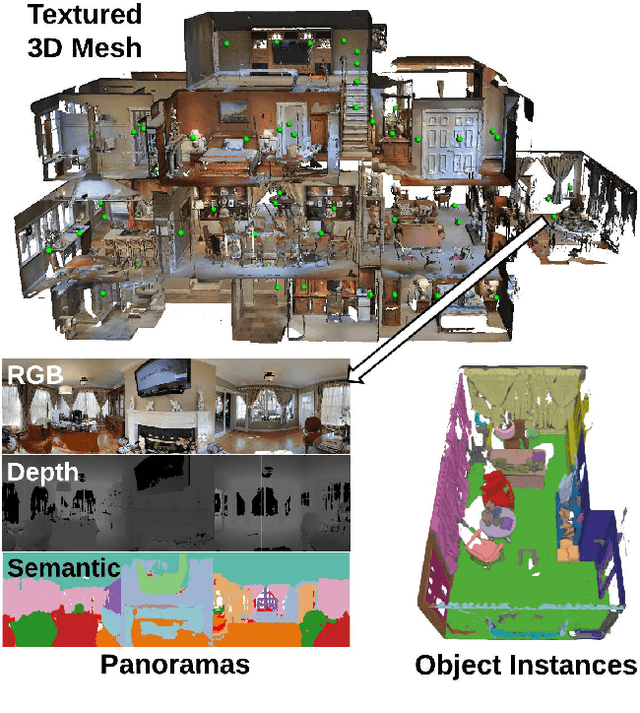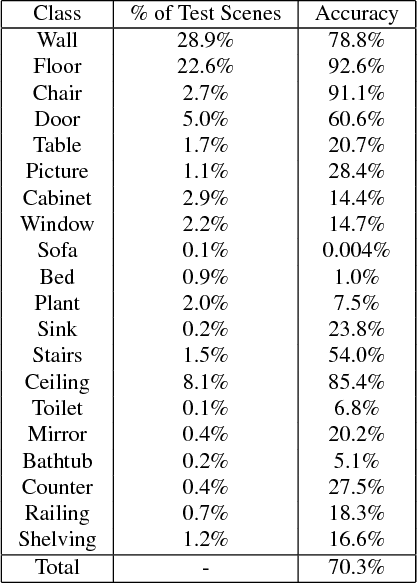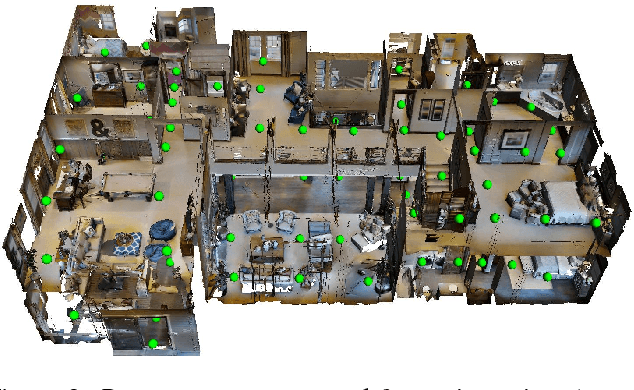Angel Chang
HomeRobot: Open-Vocabulary Mobile Manipulation
Jun 20, 2023



Abstract:HomeRobot (noun): An affordable compliant robot that navigates homes and manipulates a wide range of objects in order to complete everyday tasks. Open-Vocabulary Mobile Manipulation (OVMM) is the problem of picking any object in any unseen environment, and placing it in a commanded location. This is a foundational challenge for robots to be useful assistants in human environments, because it involves tackling sub-problems from across robotics: perception, language understanding, navigation, and manipulation are all essential to OVMM. In addition, integration of the solutions to these sub-problems poses its own substantial challenges. To drive research in this area, we introduce the HomeRobot OVMM benchmark, where an agent navigates household environments to grasp novel objects and place them on target receptacles. HomeRobot has two components: a simulation component, which uses a large and diverse curated object set in new, high-quality multi-room home environments; and a real-world component, providing a software stack for the low-cost Hello Robot Stretch to encourage replication of real-world experiments across labs. We implement both reinforcement learning and heuristic (model-based) baselines and show evidence of sim-to-real transfer. Our baselines achieve a 20% success rate in the real world; our experiments identify ways future research work improve performance. See videos on our website: https://ovmm.github.io/.
Habitat 2.0: Training Home Assistants to Rearrange their Habitat
Jun 28, 2021



Abstract:We introduce Habitat 2.0 (H2.0), a simulation platform for training virtual robots in interactive 3D environments and complex physics-enabled scenarios. We make comprehensive contributions to all levels of the embodied AI stack - data, simulation, and benchmark tasks. Specifically, we present: (i) ReplicaCAD: an artist-authored, annotated, reconfigurable 3D dataset of apartments (matching real spaces) with articulated objects (e.g. cabinets and drawers that can open/close); (ii) H2.0: a high-performance physics-enabled 3D simulator with speeds exceeding 25,000 simulation steps per second (850x real-time) on an 8-GPU node, representing 100x speed-ups over prior work; and, (iii) Home Assistant Benchmark (HAB): a suite of common tasks for assistive robots (tidy the house, prepare groceries, set the table) that test a range of mobile manipulation capabilities. These large-scale engineering contributions allow us to systematically compare deep reinforcement learning (RL) at scale and classical sense-plan-act (SPA) pipelines in long-horizon structured tasks, with an emphasis on generalization to new objects, receptacles, and layouts. We find that (1) flat RL policies struggle on HAB compared to hierarchical ones; (2) a hierarchy with independent skills suffers from 'hand-off problems', and (3) SPA pipelines are more brittle than RL policies.
On Evaluation of Embodied Navigation Agents
Jul 18, 2018Abstract:Skillful mobile operation in three-dimensional environments is a primary topic of study in Artificial Intelligence. The past two years have seen a surge of creative work on navigation. This creative output has produced a plethora of sometimes incompatible task definitions and evaluation protocols. To coordinate ongoing and future research in this area, we have convened a working group to study empirical methodology in navigation research. The present document summarizes the consensus recommendations of this working group. We discuss different problem statements and the role of generalization, present evaluation measures, and provide standard scenarios that can be used for benchmarking.
Matterport3D: Learning from RGB-D Data in Indoor Environments
Sep 18, 2017



Abstract:Access to large, diverse RGB-D datasets is critical for training RGB-D scene understanding algorithms. However, existing datasets still cover only a limited number of views or a restricted scale of spaces. In this paper, we introduce Matterport3D, a large-scale RGB-D dataset containing 10,800 panoramic views from 194,400 RGB-D images of 90 building-scale scenes. Annotations are provided with surface reconstructions, camera poses, and 2D and 3D semantic segmentations. The precise global alignment and comprehensive, diverse panoramic set of views over entire buildings enable a variety of supervised and self-supervised computer vision tasks, including keypoint matching, view overlap prediction, normal prediction from color, semantic segmentation, and region classification.
Text to 3D Scene Generation with Rich Lexical Grounding
Jun 05, 2015



Abstract:The ability to map descriptions of scenes to 3D geometric representations has many applications in areas such as art, education, and robotics. However, prior work on the text to 3D scene generation task has used manually specified object categories and language that identifies them. We introduce a dataset of 3D scenes annotated with natural language descriptions and learn from this data how to ground textual descriptions to physical objects. Our method successfully grounds a variety of lexical terms to concrete referents, and we show quantitatively that our method improves 3D scene generation over previous work using purely rule-based methods. We evaluate the fidelity and plausibility of 3D scenes generated with our grounding approach through human judgments. To ease evaluation on this task, we also introduce an automated metric that strongly correlates with human judgments.
 Add to Chrome
Add to Chrome Add to Firefox
Add to Firefox Add to Edge
Add to Edge